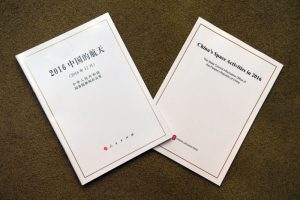As part of the new partnership between SpaceWatch Middle East and The Précis, a quarterly space law and policy report produced by Space Law & Policy Solutions, run by the prominent space lawyer and friend of SpaceWatch Middle East, Michael J. Listner, SpaceWatch Middle East is occasionally publishing select articles from The Précis. Reproduced here are Michael’s Four Guidelines to China’s Outer Space White Paper from a Special Issue of The Précis from January 5, 2017. Details of how to subscribe to The Précis are provided at the end of this commentary.

The State Council Information Office of the People’s Republic of China issued a status report from the China National Space Administration titled White Paper on China’s Space Activities in 2016. The White Paper is the first issued under Chinese President Xi Jingping.[1] The talking points of the White Paper are organized under seven primary headings:
Preamble
I. Purposes, Vision and Principles of Development
II. Major Developments Since 2011[2]
III. Major Tasks for the Next Five Years
IV. Policies and Measures for Development
V. International Exchanges and Cooperation
Conclusion
This Special Issue of The Précis provides Subscribers four guidelines to consider while construing the talking points of the White Paper.
Guideline 1

Readers should take into consideration this White Paper is an English translation from the original Mandarin, which means some terms and nuances within may not transfer word-for-word nor be fully articulated. This is not an uncommon issue as the translation from one language to another not only implicates improper grammar and usage but also tends to cloud cultural perspective.
Guideline 2
The White Paper is couched in terms of China’s “civilian” space program, but the shadow of the People’s Liberation Army (PLA) is ubiquitous. The term “national security” appears three times in the White Paper, and it is worded as a generalization rather than a military specific idiom. However, there is no solid delineation between the activities of the PLA and the CNSA, which means the goals, activities and policies expressed in the White Paper should also be taken in the context of its potential for peaceful and non-peaceful, military purposes and not just in the pronounced context of non-military purposes.[3]
Guideline 3
Particular attention should be paid to both the Preamble and the Purposes, Vision and Principles of Development headings as they are fundamental to the rest of the White Paper. Both sections frame the context of the goals and policies enunciated in the White Paper in terms of the world view of President Xi Jingping. In particular, the Preamble and Purposes, Vision and Principles of Development headings embody President Xi’s vision to consummate the Chinese Dream of the renewal of the Chinese nation.[4] While reviewing the talking points of the White Paper, Subscribers should reflect on:
- The concept of the Chinese Dream in the Preamble;
- The Purpose and role of outer space to the Chinese Dream;
- The Vision of space power as it relates to the Chinese Dream; and
- The Principles through which outer space will play a role in realizing the Chinese Dream.
Talking points within the White Paper should be cast in the nationalistic light of the Chinese Dream and not be taken from the perspective of globalist or Western ideology. The Chinese Dream underlies the White Paper’s talking points of past and present accomplishments and future goals of infrastructure, activities and policy. These talking points are not standalone and to exclude the concept of the Chinese Dream while reviewing them would misrepresent the frame of reference the talking points are expressed in.
Guideline 4
The White Paper is intended for a domestic and global audience and as such represents a soft power tool and an instrument of propaganda. As inspiring as the accomplishments, goals and policies stated in the White Paper may be, they are designed to put a public face on China’s outer space aspirations and may not be indicative of the true internal goals, policies and capabilities of the People’s Republic of China. Indeed, the White Paper’s talking points should be taken in context of China’s past, present and future actions on the world stage and not accepted at face value.
[1] Xi JingPing’s full title is that of General Secretary of the Communist Party of China, President of the People’s Republic of China, and Chairman of the Central Military Commission.
[2] China’s last outer space white paper, China’s Space Activities in 2011, was published on December 29, 2011 and can be found at http://news.xinhuanet.com/english/china/2011-12/29/c_131333479.htm
[3] China goes to great length in the White Paper to reiterate the precepts of “peaceful purposes” as articulated in the Preamble of the Outer Space Treaty. It’s critical to understand the prevailing customary interpretation of “peaceful purposes” does not exclude military activity but only that activity which is aggressive in nature. This would validate PLA’s involvement in China’s outer space activity but certainly would not be consistent with their demonstrated ASAT capabilities.
[4] The motto of the “Chinese Dream” was adopted by Xi when he ascended to the role of General Secretary in 2012 and has since become part of the idiolect of China’s Communist Party. The paradigm of the Chinese Dream adopted as Party doctrine is a nationalistic one as opposed to a globalist viewpoint and emphasizes Chinese prosperity, collective effort, socialism, and national glory. The concept of the “Chinese Dream” is not a new ideological construct as it is found in ancient Chinese scholarly writings.
Disclaimer
The Précis is a product of Space Law & Policy Solutions. Opinion, commentary and analysis contained in The Précis is for informational purposes. The Précis is not legal advice nor is it a substitute for legal advice. Subscription to The Précis does not create an attorney/client relationship nor is information contained within protected by attorney/client privilege. The Précis may not be reproduced, distributed, or transmitted in any form or by any means, including but not limited to photocopying, edits, website uploads or other electronic or mechanical methods, except for quotations with proper citation, without the express permission of the author.
SpaceWatch Middle East thanks Michael J. Listner for permission to republish his work.
To subscribe to The Précis please visit: http://www.spacelawsolutions.com/the-pr-cis-.html
Republished at: http://www.spacewatchme.com/2017/01/precis-four-guidelines-chinas-outer-space-white-paper
 SpaceWatch.Global An independent perspective on space
SpaceWatch.Global An independent perspective on space

